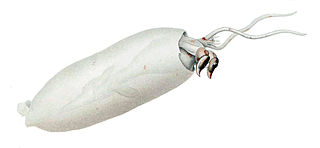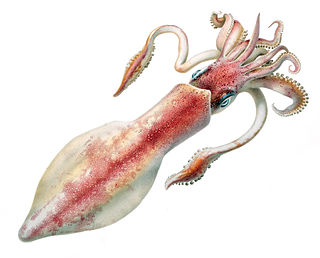| Pickfordiateuthis | |
|---|---|
| Scientific classification | |
| Kingdom: | Animalia |
| Phylum: | Mollusca |
| Class: | Cephalopoda |
| Order: | Myopsida |
| Family: | Loliginidae |
| Genus: | Pickfordiateuthis Voss, 1953 [1] |
| Type species | |
| Pickfordiateuthis pulchella Voss, 1953 | |
| Species | |
| |
Pickfordiateuthis is a genus of tiny squid in the family Loliginidae. While four species have been assigned to the genus, only three have been named. No member is known to reach a maximum mantle length of more than 22 mm. [2]

Squid are cephalopods in the superorder Decapodiformes with elongated bodies, large eyes, eight arms and two tentacles. Like all other cephalopods, squid have a distinct head, bilateral symmetry, and a mantle. They are mainly soft-bodied, like octopuses, but have a small internal skeleton in the form of a rod-like gladius or pen, made of chitin.

Loliginidae, commonly known as pencil squids, is an aquatic family of squid classified in the order Myopsida.

The mantle is a significant part of the anatomy of molluscs: it is the dorsal body wall which covers the visceral mass and usually protrudes in the form of flaps well beyond the visceral mass itself.
The genus was erected in 1953 by Gilbert L. Voss, who named it in honour of biologist Grace Evelyn Pickford. [3] Voss placed the sole species known at the time, P. pulchella , in its own family, Pickfordiateuthidae, but this was sunk in synonymy with Loliginidae by Thomas Brakoniecki in his 1996 revision of Pickfordiateuthis. [4] Brakoniecki also described P. vossi as new and identified a third, unnamed species, P. sp. A. [4] A fourth species, P. bayeri , was added in 2001 by Clyde Roper and Michael Vecchione. [5]
Gilbert L. Voss was an American conservationist and oceanographer. He was one of the main persons behind the establishment of John Pennekamp Coral Reef State Park in Florida and he spoke out successfully against several proposed real estate developments that might have threatened the ecology of the Florida Keys.
Pickfordiateuthis pulchella, the grass squid, is a species of squid in the family Loliginidae.

In taxonomy, an undescribed taxon is a taxon that has been discovered, but not yet formally described and named. The various Nomenclature Codes specify the requirements for a new taxon to be validly described and named. Until such a description has been published, the taxon has no formal or official name, although a temporary, informal name is often used. A published scientific name may not fulfil the requirements of the Codes for various reasons. For example, if the taxon was not adequately described, its name is called a nomen nudum. It is possible for a taxon to be "undescribed" for an extensive period of time, even if unofficial descriptions are published.













